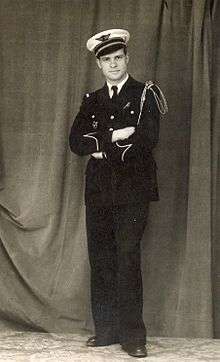Roger Grosjean
Roger Grosjean (25 July 1920 – 7 June 1975) started his career as a French Air Force fighter pilot in France, England and North Africa. This involved a short stint as a Security Service (MI5) double agent during World War II (code name FIDO). He then became a successful archeologist in Corsica.[1][2][3]

Grosjean was born on 25 July 1920, in Chalon-sur-Saône, France. He entered the French Air Force in 1939 and spent the next three years in various postings, among them Fighter Group (GC) 2/1 in Le Luc, Var. When the Germans invaded the non-occupied part of France in November 1942, Grosjean was demobilized.
So as to join Charles de Gaulle in London, he put together a very risky strategy: he made the Germans believe that if they helped him get over to England, he would send back various types of information. Grosjean reached England in July 1943 and reported his cover story at the start of his stay at the Royal Victoria Patriotic School (London Reception Centre). He agreed to act as a double agent for the Security Service (MI5) and was part of the Double-Cross System from August 1943 to May 1944.[4]
During that time he was also a member of the Free French Air Force. In the summer of 1944 he was sent to Algeria and then to Morocco where he was an instructor on P-39s. He ended his French Air Force career in 1946 and was awarded a number of French distinctions, among them the Legion of Honour.
After a transition period, during which he trained as an archeologist and took part in digs with L'Abbé Henri Breuil, the famous French archeologist, he joined the French National Centre for Scientific Research (CNRS). In 1954, he left for Corsica and began what was to be a very successful research career spanning twenty years studying the Corsican megalithic civilization. He uncovered sculpted menhirs at Filitosa, Cauria and Palaghju, for example, as well as megalithic fortified settlements at Alo-Bisucce, Cucuruzzu and Araghju.
In the summer of 1975, at the height of his career, and while working on his new museum in Sartène, Grosjean died of a heart attack. He was fifty-four years old.
An illustrated biography of Grosjean was published in 2011[5] by his son, François Grosjean, who also wrote an article about him in British Archaeology in 2012.[6] A few years later he wrote a book on his search of his two parents, Roger and Sallie, whom he did not know well as a child.[7]
Selected publications
- Grosjean, R. (1955). Les statues-menhirs de la Corse I. Études corses, 7-8, 5-36.
- Grosjean, R. (1961). Filitosa et son contexte archéologique. Monuments et Mémoires Piot T. 52 - Paris: P.U.F.
- Grosjean, R. (1964). Le complexe torréen fortifié de Cucuruzzu (Levie, Corse). Première campagne de fouilles 1963. Bulletin de la société préhistorique française, LXI, 1, 185-194.
- Grosjean, R. (1966). La Corse avant l’histoire. Paris: Klincksieck.
- Grosjean, R. (1966). Recent work in Corsica. Antiquity, XL, 159, 190-198.
- Grosjean, R. (1967). Le complexe monumental fortifié torréen du Castello d’Araggio (Commune de San-Gavinodi-Garbini. Corse). Bulletin de la société préhistorique française, LXV, 9, cclvj-cclcvij.
- Grosjean, R. (1968). Nouvelles statues-stèles découvertes en Corse. Bulletin de la société préhistorique française, LXV, 8, 195-198.
- Grosjean, R. (1972). Les alignements de Pagliaiu (Sartène, Corse). Bulletin de la société préhistorique française, LXIX, 2, 607- 617.
- Grosjean, R. (1975). Torre et Torréens : Âge du Bronze de l’île de Corse. Collection: Promenades archéologiques, 3. Centre de Préhistoire corse.
References
- Masterman, J. C. (1972). The Double-Cross System. Yale, USA: Yale University Press.
- West, N. (1981). MI5: British Security Service Operations 1909-1945. London, England: Triad Grafton Books.
- West, N. (Ed.) (2005). The Guy Liddell Diaries. Vol. II. 1942-1945. London, England: Routledge.CS1 maint: extra text: authors list (link)
- Grosjean, F. (2010). "FIDO: French pilot and Security Service double agent malgré lui". International Journal of Intelligence and CounterIntelligence. 23 (2): 337–352. doi:10.1080/08850600903348879.
- Grosjean, F. (2011). Roger Grosjean: Itinéraires d'un archéologue. Ajaccio, Corsica (France): Editions Alain Piazzola.
- Grosjean, F. (2012). "Roger Grosjean and the stone men of Corsica". British Archaeology (July August): 24–27.
- Grosjean, F. (2016). A la recherche de Roger et Sallie. Hauterive, Switzerland: Editions Attinger.